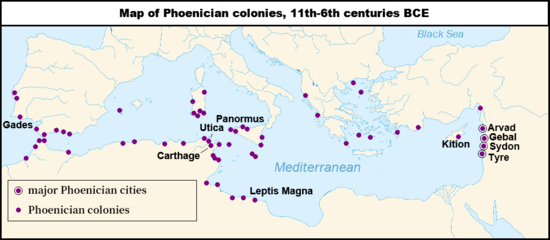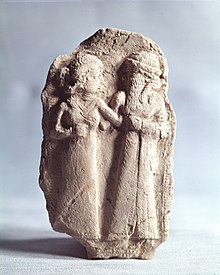THE PHOENICIA PORTAL

The Phoenicians were an ancient Semitic group of people who lived in the Phoenician city-states along a coastal strip in the Levant region of the eastern Mediterranean, primarily modern Lebanon. They developed a maritime civilization which expanded and contracted throughout history, with the core of their culture stretching from Arwad in modern Syria to Mount Carmel. The Phoenicians extended their cultural influence through trade and colonization throughout the Mediterranean, from Cyprus to the Iberian Peninsula.
The Phoenicians directly succeeded the Bronze Age Canaanites, continuing their cultural traditions following the decline of most major cultures in the Late Bronze Age collapse and into the Iron Age without interruption. It is believed that they self-identified as Canaanites and referred to their land as Canaan, indicating a continuous cultural and geographical association. The name Phoenicia is an ancient Greek exonym that did not correspond precisely to a cohesive culture or society as it would have been understood natively. Therefore, the division between Canaanites and Phoenicians around 1200 BC is regarded as a modern and artificial division.
The Phoenicians, known for their prowess in trade, seafaring and navigation, dominated commerce across classical antiquity and developed an expansive maritime trade network lasting over a millennium. This network facilitated cultural exchanges among major cradles of civilization, such as Greece, Egypt, and Mesopotamia. The Phoenicians established colonies and trading posts across the Mediterranean; Carthage, a settlement in northwest Africa, became a major civilization in its own right in the seventh century BC.
The Phoenicians were organized in city-states, similar to those of ancient Greece, of which the most notable were Tyre, Sidon, and Byblos. Each city-state was politically independent, and there is no evidence the Phoenicians viewed themselves as a single nationality. While most city-states were governed by some form of kingship, merchant families probably exercised influence through oligarchies. After reaching its zenith in the ninth century BC, the Phoenician civilization in the eastern Mediterranean gradually declined due to external influences and conquests. Yet, their presence persisted in the central and western Mediterranean until the destruction of Carthage in the mid-second century BC. — Read more about Phoenicia, its mythology and language
 Featured article
•
Featured article
•
A Featured article represents some of the best content on Wikipedia
The Roman temple of Bziza is a well-preserved first century AD building dedicated to Azizos, a personification of the morning star in ancient Arab polytheism. This Roman temple lends the modern Lebanese town of Bziza its current name, as Bziza is a corruption of Beth Azizo meaning the house or temple of Azizos. Azizos was identified as Ares by Emperor Julian.
The tetrastyle prostyle building has two doors that connect the pronaos to a square cella. To the back of the temple lie the remains of the adyton where images of the deity once stood. The ancient temple functioned as an aedes, the dwelling place of the deity. The temple of Bziza was converted into a church and underwent architectural modification during two phases of Christianization; in the Early Byzantine period and later in the Middle Ages. The church, colloquially known until modern times as the Lady of the Pillars, fell into disrepair. Despite the church's condition, Christian devotion was still maintained in the nineteenth century in one of the temple's niches. The temple of Bziza is featured on multiple stamps issued by the Lebanese state. (Full article...)
Phoenician mythology •
Adon (Phoenician: 𐤀𐤃𐤍) literally means "lord." Adon has an uncertain etymology, although it is generally believed to be derived from the Ugaritic ad, “father.” (Full article...)
Images
 Good article
•
Good article
•
A Good article meets a core set of high editorial standards
Dumuzid or Dumuzi or Tammuz (Sumerian: 𒌉𒍣, romanized: Dumuzid; Akkadian: Duʾūzu, Dûzu; Hebrew: תַּמּוּז, romanized: Tammūz), known to the Sumerians as Dumuzid the Shepherd (Sumerian: 𒌉𒍣𒉺𒇻, romanized: Dumuzid sipad) and to the Canaanites as Adon (Phoenician: 𐤀𐤃𐤍; Proto-Hebrew: 𐤀𐤃𐤍), is an ancient Mesopotamian and associated with agriculture and shepherds, who was also the first and primary consort of the goddess Inanna (later known as Ishtar). In Sumerian mythology, Dumuzid's sister was Geshtinanna, the goddess of agriculture, fertility, and dream interpretation. In the Sumerian King List, Dumuzid is listed as an antediluvian king of the city of Bad-tibira and also an early king of the city of Uruk.
In Inanna's Descent into the Underworld, Inanna perceives that Dumuzid has failed to properly mourn her death and, when she returns from the Underworld, allows the galla demons to drag him down to the Underworld as her replacement. Inanna later regrets this decision and decrees that Dumuzid will spend half of the year in the Underworld, but the other half of the year with her, while his sister Geshtinanna stays in the Underworld in his place, thus resulting in the cycle of the seasons. In the Sumerian poem Inanna Prefers the Farmer, Dumuzid competes against the farmer Enkimdu for Inanna's hand in marriage. (Full article...)
Phoenician inscriptions & language •
The Cippi of Melqart are a pair of Phoenician marble cippi that were unearthed in Malta under undocumented circumstances and dated to the 2nd century BC. These are votive offerings to the god Melqart, and are inscribed in two languages, Ancient Greek and Phoenician, and in the two corresponding scripts, the Greek and the Phoenician alphabet. They were discovered in the late 17th century, and the identification of their inscription in a letter dated 1694 made them the first Phoenician writing to be identified and published in modern times. Because they present essentially the same text (with some minor differences), the cippi provided the key to the modern understanding of the Phoenician language. In 1758, the French scholar Jean-Jacques Barthélémy relied on their inscription, which used 17 of the 22 letters of the Phoenician alphabet, to decipher the unknown language.
The tradition that the cippi were found in Marsaxlokk was only inferred by their dedication to Heracles, whose temple in Malta had long been identified with the remains at Tas-Silġ. The Grand Master of the Order of the Knights Hospitaller, Fra Emmanuel de Rohan-Polduc, presented one of the cippi to the Académie des Inscriptions et Belles-Lettres in 1782. This cippus is currently in the Louvre Museum in Paris, while the other rests in the National Museum of Archaeology in Valletta, Malta. The inscription is known as KAI 47. (Full article...)
Did you know (auto-generated) •

- ... that according to second-century AD Greek rhetorician Athenaeus, the Phoenicians played a flute-like instrument called the gingras in their mourning rituals?
- ... that archaeological excavations in the historic town of Kharayeb revealed a rural settlement with a complex system of cisterns and a Phoenician temple?
- ... that Bochart's 1646 Geographia Sacra seu Phaleg et Canaan was the first full-length book devoted to the Phoenicians?
- ... that Muhammad Khaznadar's museum was said to have "surpassed every other museum in the world" in Phoenician and Carthaginian antiquities?
- ... that the discovery of Phoenician metal bowls in 1849 created the entire concept of Phoenician art?
- ... that alongside a 7th-century BC Phoenician shipwreck, two additional wrecks from various historical periods were unearthed in Bajo de la Campana, situated off the coast of Cartagena, Spain?



























